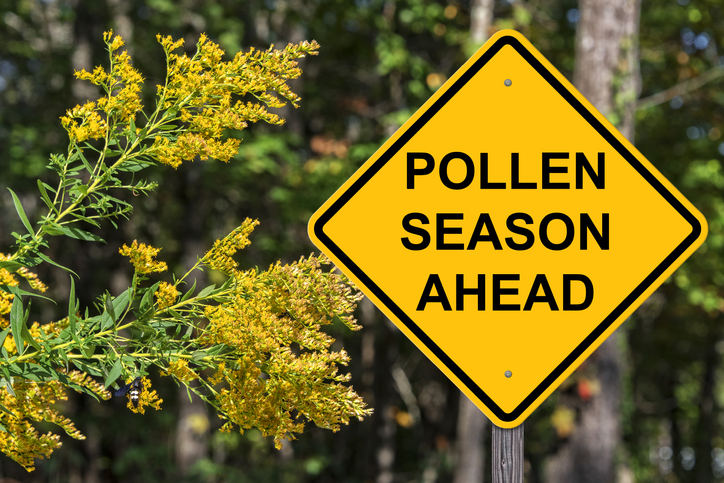Click here to Subscribe to Chips Tips Blog
Are Seasonal Allergies Ruining Your Spring? We Can Fix That!

Canada has recently made international environmental headlines for having some of the cleanest outdoor air on the planet.
Yet one out of every six Canadians reports suffering from seasonal allergies.
With a clear link between air quality and allergy symptoms, something about this doesn’t add up. If you are suffering through spring with seasonal allergies, you probably want to know why!
As it turns out, outdoor air quality is not the real issue when it comes to reducing allergy symptoms. What matters most is the quality of your indoor air.
In this post, we take a closer look at Canada’s declining indoor air quality, how that relates to allergy symptoms and, most importantly, what you can do about it!
Our Indoor Air Quality Is Getting Worse
According to the U.S. Environmental Protection Agency, the quality of the average North American homeowner’s indoor air is up to five times worse than the air outside.
Five times worse is a lot worse! What could be causing such indoor air toxicity?
The EPA’s report identified two main factors that are responsible for our ever-worsening indoor air quality.
The first factor is airtight construction. Airtight construction standards that aim to reduce energy waste have inadvertently created buildings that cannot organically self-ventilate. This creates conditions where indoor air becomes increasingly stale, oxygen-poor and toxic.
The second factor is what we are adding to our already stale indoor air. Commercial cleaning products, air fresheners and candles, treated home furnishings, personal care products and fragrances, pesticides and herbicides, tobacco smoke, appliances and office equipment all produce potentially hazardous airborne toxins that then become trapped inside with us.
Luckily, you have a number of options for correcting both issues and cleaning up your indoor air.
Addressing Airtight Spaces With Assisted Ventilation
As of just two years ago, Ontario invoked a new requirement that all Toronto-area new construction must include installation of a heat recovery ventilator.
The heat recovery ventilator, or HRV for short, provides continuous assisted ventilation for airtight spaces, correcting mechanically what is no longer happening organically.
Heat recovery ventilators and their humid climate counterparts, energy recovery ventilators, separate incoming fresh air and outgoing stale air to ensure there is never any crossover. They can also help remove airborne toxins and balance indoor humidity levels seasonally.
Heat and energy recovery ventilation systems can be retrofitted to work with any existing central (ducted) HVAC system. Portable models are also available for homes and workplaces that do not have existing ductwork.
How Toxins Get Into Your Indoor Air
Energy and heat recovery ventilators can go a long way toward pushing existing toxins and pollutants out of your home or office and keeping your indoor air oxygenated, fresh and breathable.
But these appliances can’t fix the whole problem of declining indoor air quality all by themselves.
This is because we are continually introducing new pollutants and toxins into our indoor air through many daily choices we make.
For example, did you know that many commercially available cleaning products and personal care products with fragrance as well as many perfumes, candles and air fresheners are little more than potent chemical concoctions that release volatile organic compounds (VOCs) and other gaseous toxins into the air?
They may smell great and may work great to mask less pleasant odours, but they exact a price for this service in the form of respiratory distress, mental fogginess, headache, dizziness and coughing fits, as well as asthma and allergy symptoms.
Use of tobacco products, fireplaces, stoves, HVAC equipment, office equipment and other appliances can off-gas VOCs, carbon monoxide and even ozone.
Radon, a naturally occurring by-product of decaying uranium, is the second leading cause of non-tobacco related lung cancer in Canada. It is present inside many homes and workplaces throughout Canada.
Many new home and office furnishings, including carpeting, mini-blinds, pet bedding, mattresses, draperies and furniture, can off-gas formaldehyde and other toxic chemicals that are used in their creation and construction.
Home renovation and craft supplies, including glues, adhesives, paint and primer, insulation and composites can off-gas as well, adding a hidden cost to the bottom-line savings of the do-it-yourself movement.
Pet dander, dust mites, mould, mildew and that ever-present spring culprit, pollen, all get trapped once they enter your home or work space. Once inside, they begin to circulate repeatedly as your HVAC system cycles on and off, continually challenging your immune system to fight back against the unpleasant health symptoms they cause.
So now you know why you can’t seem to shake your allergy or asthma symptoms even after you have retreated indoors.
Addressing Indoor Air Toxicity With Modern Air Quality Helps
Luckily, a range of options exist to clean, filter and purify your indoor air and remove toxins that keep you feeling less than 100 percent.
There are two main types of airborne pollutants that are continually circulated, trapped by airtight construction, inside your home or workplace. These two types of toxins are gaseous and particulates.
Ultraviolet air purification
Ultraviolet, or UV, air purifiers are designed to work primarily to neutralize gaseous pollutants such as volatile organic compounds, radon, carbon monoxide, formaldehyde and other organic chemical compounds.
UV air purifiers use the most powerful ultraviolet light band (UV-C) to neutralize these airborne chemicals by changing their molecular structure and rendering them harmless.
Air filtration
Air filtration systems are designed to work primarily to trap and filter out tiny airborne particulate matter.
Dust, dust mites, pet dander, pollen, mould/mildew spores, bacteria, viral matter and smoke residue get trapped in the intricate, deep folds of the air filters and are permanently removed from our indoor air supply.
Get in Touch
Do you need help to beat spring allergies by improving your indoor air quality?
Contact us online or give us a call at 877-885-3403.
P.S. Don’t forget to sign up to receive Chip’s Tips by email each month - it's free!

